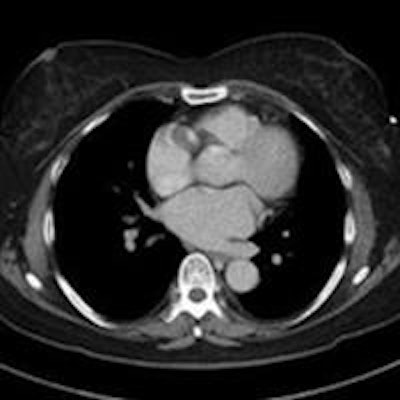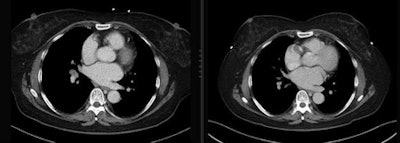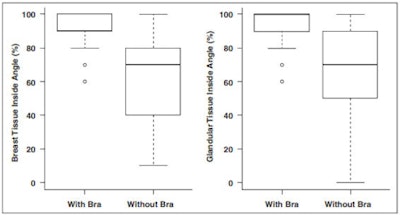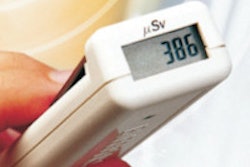
Wearing a bra during a chest CT scan can significantly reduce dose to radiosensitive tissues by holding breast tissue within the lower-dose region created by tube-current modulation techniques, concludes a new study in the May issue of the American Journal of Roentgenology.
The study examined close to 600 women undergoing chest CT: 209 wore bras, while 369 did not and served as the control group. CT data were acquired using angle-dependent tube current modulation, which reduces tube current in the anterior tube position to minimize exposure to anteriorly located organs.
In the bra-wearing group, 91% to 96% (depending on cup size) of glandular tissue was located inside the region of tube current modulation and, thus, experienced less radiation dose. Meanwhile, the percentage was just 60% to 67% for the women not wearing bras.
"Wearing a brassiere increases the percentage of breast tissue within the region of reduced tube current and, therefore, improves the performance of angle-dependent tube-current modulation technique," wrote Dr. Anna Seidenfuss and colleagues from University Erlangen-Nuremberg in Germany (AJR, May 2014, Vol. 202:5, pp. W447-W452).
"Our particular concern is radiation dose to the glandular tissue of the breast, especially in younger women," Seidenfuss told AuntMinnie.com in an email. "We consider this group the most important as they are at the highest risk of radiation-induced cancer."
More susceptible to radiation
These days breast tissue is considered to be one of the most radiosensitive organs in the body, Seidenfuss said. Several strategies have been proposed to reduce dose to radiosensitive organs consistent with the ALARA (as low as reasonably achievable) principle.
Dose-reduction techniques already in clinical use include tube current modulation, automated exposure control, electrocardiogram pulsing, high-pitch scanning, iterative reconstruction, and low-kV scanning. Breast shielding with lead or bismuth foil has also been proposed, but the single-use shields are expensive and associated with artifacts, the authors noted.
One promising dose-reduction technique is organ-based tube current modulation, which reduces exposure to the breast by up to 42% without loss of image quality; a commercially available tool tested by Ketelsen et al can reduce dose by one-third, the team wrote.
More can be achieved if more breast tissue can be kept inside the angle-dependent automated tube-current modulation area. But current practice in most imaging centers may work against this type of dose reduction.
"Such angle-dependent tube-current modulation techniques have been proposed and validated in different phantom experiments, which demonstrated that significant dose reduction can be achieved without sacrificing image quality," according to Seidenfuss. "But while phantom measurements are necessary for direct measurement of glandular tissue exposure, they only represent an idealized anatomy."In many institutions, it is standard practice for female patients to be instructed to take off their bras before chest CT and to only wear a T-shirt or hospital gown, the authors wrote.
For their study, the authors aimed to evaluate the proportions of the female breast and glandular tissue that are within the range of angle-dependent tube current modulation, and whether the proportions could be optimized by keeping the bra on. They also looked into whether the metal parts of bras cause artifacts that impair the diagnostic value of the images.
The study included 578 women undergoing chest CT for various indications, with 209 scanned while wearing a bra (group A) and 369 serving as the control group (group B). Images were acquired on a single-source 128-detector-row MDCT system (Somatom Definition AS+, Siemens Healthcare).
 24-year-old woman with malignant melanoma. Patient is wearing (right) and not wearing (left) a bra during the CT scan. All images republished with permission of the American Roentgen Ray Society.
24-year-old woman with malignant melanoma. Patient is wearing (right) and not wearing (left) a bra during the CT scan. All images republished with permission of the American Roentgen Ray Society.The researchers used angle-dependent tube current modulation (X-Care, Siemens), which reduces tube current to 20% of the setting for direct irradiation of breast tissue; image quality is maintained by adjusting tube current in the other projections. Measurements were performed on a dedicated 3D workstation (Syngo.via, Siemens).
Two independent readers rated artifacts on a three-point Likert scale, with 0 meaning no relevant artifacts, 1 indicating artifacts impairing evaluation of breast tissue, and 2 indicating artifacts impairing evaluation of breast tissue or chest organs.
More protected with bras
The results showed that 91.3% of total breast tissue and 96% of glandular tissue were within the region of tube current reduction in group A. The same values were 60.4% and 67.1%, respectively, for group B.
In terms of tissue protected within the anterior 120° of projection of the automated tube current modulation, older patients improved more than younger patients by wearing a bra.
The percentage of breast tissue covered by tube current modulation among 16- to 40-year-old women rose from 76.9% to 94.2% with bra use. Among 41- to 65-year-old patients, the region covered rose from 55.3% to 92.1% of breast tissue, and among 66- to 89-year-olds, the percentage of covered breast tissue increased from 52.7% to 88.3%, the authors wrote.
The impact of wearing a bra varied in patients with different cup sizes. Cup size A saw the best results, with 97.5% of breast tissue and 98.1% of glandular tissue inside the reduction region with a bra, the authors wrote. Cup size E showed the biggest improvement: 83.3% of breast tissue and 90% of glandular tissue were covered using a bra, compared with only 30% of breast tissue and 31.8% of glandular tissue without the undergarment.
 Distribution of percentages of breast tissue (left) and glandular tissue (right) inside angle of reduced-dose x-ray beam for patients wearing and not wearing a bra during CT scanning. Thick solid lines within boxes denote median, circles denote outliers, boxes indicates interquartile range (IQR), and thin horizontal lines denote 1.5 x IQR.
Distribution of percentages of breast tissue (left) and glandular tissue (right) inside angle of reduced-dose x-ray beam for patients wearing and not wearing a bra during CT scanning. Thick solid lines within boxes denote median, circles denote outliers, boxes indicates interquartile range (IQR), and thin horizontal lines denote 1.5 x IQR.Younger patients benefit least
"We found an age-dependent correlation of the effects, with less improvement in the youngest patients," the authors wrote. "We consider this group to be the most important because they are at the highest risk of radiation-induced cancer."
Bismuth shielding has been found to reduce dose to the breast surface by about 50%, but it also introduces artifacts and can significantly decrease image signal and contrast, the authors wrote. In this study, however, there were no artifacts influencing the diagnostic value of the study, even though several types of bras were used.
"In conclusion, we have shown in a large patient cohort that 'placement' of the female breast by keeping a brassiere on during chest CT does not negatively influence image quality but increases the effect of dose reduction of angle-dependent tube-current modulation algorithms," Seidenfuss and colleagues wrote.




















